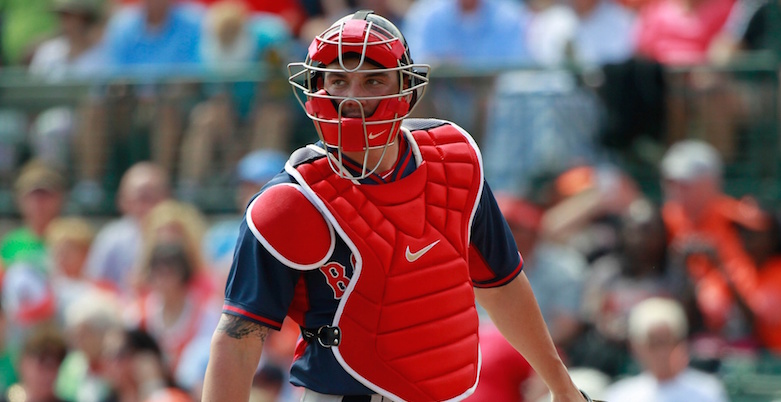Christian Vazquez is a 24-year-old all-world defensive catcher and, most unfortunately, a recent casualty of Tommy John surgery. It’s not often that losing a player who posted a .239 TAv in his first 201 major league plate appearances – and who’s only projected for a .244 TAv in 2015 – can be classified as a major loss, but Vazquez’s preseason injury forced Boston’s hand into a stretch of suboptimal roster shuffling.
Left with insufficient time to find a legitimate replacement for Vazquez, the Red Sox were forced to push 34-year-old Ryan Hanigan into the starting catcher spot, a role he might have been better suited for three or four years ago. It also forced the Sox to acquire a new backup in Sandy Leon, whose minor league batting statistics automatically categorize him in the defense-first catcher bucket. He’s not surprisingly hit a cringe-worthy .174/.269/.174 in limited playing time. Then, after an errant pitch decided to ricochet off Hanigan’s right hand, the Red Sox were forced to call-up 23-year-old catching prospect Blake Swihart, probably a year before they wanted to make that move.
The loss of Vazquez has obviously changed the entire complexion of Boston’s catching outlook for 2015, but let’s focus more closely on how it has impacted one part of a catcher’s responsibility: pitch framing. As Matthew Kory outlined in early April, the Sox were bound to miss Vazquez’s pitch framing skills, as he was worth 14.1 framing runs in just 3,170 framing chances in 2014. Among catchers who racked up at least 3,000 framing chances in 2014, here’s where Vazquez ranked:
| Player | Framing Chances | Framing Runs/7,000 Pitches |
| 1) Hank Conger | 4,540 | 36.9 |
| 2) Rene Rivera | 4,888 | 36.1 |
| 3) Christian Vazquez | 3,170 | 31.3 |
| 4) Buster Posey | 5,836 | 30.6 |
| 5) Yasmani Grandal | 4,105 | 29.2 |
Vazquez, pitch for pitch, was one of the best framers in the majors in 2014 — and because framing ability stabilizes so quickly, we don’t have to chalk up his success to small sample flukiness. But Vazquez won’t frame a single pitch this season — darn it — so let’s focus on how the rest of Boston’s catching trio has fared framing pitches, and what we might expect out of them going forward.
Hanigan, as Kory discussed, was expected to be a good pitch framer headed into the season, at least somewhat mitigating the absence of Vazquez. From 2009 through 2012, Hanigan was worth at least 18.7 framing runs per 7,000 pitches (FR/7,000) in every season, and in 2011 his 27.3 FR/7,000 ranked sixth in all of baseball (min. 3,000 framing chances). Hanigan’s framing numbers declined in 2013 and 2014, but he remained a plus pitch framer, posting an FR/7,000 of 8.8 in those two seasons.
This year, though, the results have been surprisingly subpar. According to BP’s framing metric, Hanigan has actually cost the Red Sox five strikes, or -.8 runs, or -4.8 runs when extrapolated over a full season’s worth of work. (StatCorner has Hanigan as a plus framer — though only narrowly – in 2015.) Your inclination is probably to question the sample size, but here’s what Jonathan Judge, Harry Pavlidis, and Dan Brooks recently said about the quick stabilization of framing stats:
“After only 10% of the season (about three weeks) a catcher’s 2014 CSAA sports a .81 correlation to his final number. After 30% of the season (about 2 months), the correlation is over .9. This isn’t just for full-time catchers either: this data set includes catchers like Humberto Quintero, who had a mere 35 framing opportunities last year. CSAA is not only a skill, but one that manifests itself quickly and with effect.”
What are some potential reasons for Hanigan’s decline?
1) Aging – Framing pitches, like most other baseball skills, is a young man’s game. According to the BP framing article linked to earlier, “framing ability peaks around age 25, declines gradually until about 32, and then starts falling off a cliff, although certain catchers (the Jose Molinas of the world) hold on to the ability longer than most.” It’s possible that a 34-year-old Hanigan, who displayed signs of mild decline as a 32- and 33-year-old, has fallen off the proverbial pitch framing cliff.
2) The league getting better – One of the possible theories Rob Arthur posited in an article at FiveThirtyEight, when discussing the rapid decline of pitch framing deity Yadier Molina, is the league’s improvement as a whole in pitch framing over recent years. Instead of Molina’s – or Hanigan’s – skills actually deteriorating in any meaningful way, perhaps the rest of the league has simply gotten better at framing pitches. As teams have afforded more catching opportunities to no-bat, all-frame specialists, Hanigan’s once standout framing skills look more pedestrian by comparison.
3) Switching teams – Maybe moving from one team to another — like Hanigan did in jumping from the Rays to the Padres (albeit briefly) to the Red Sox this offseason – triggers an adjustment period for pitch framing, as catchers need time to learn how to frame a new set of pitchers. Then again, this year’s pitch framing leaderboard features four team-switchers – Yasmani Grandal, Francisco Cervelli, Russell Martin, and Miguel Montero — among its top 10, so you can probably scratch that theory.
4) Composition of pitching staff – Consider this nugget from a Ben Lindbergh Q&A with Hanigan from a couple of years ago:
From 2008 to present, Hanigan has been above league average in getting strikes on called pitches outside the zone by 2 inches or less:
- Above the zone: 51 percent above average
- Below the zone: 37 percent above average
- Off the edges: 29 percent above average
Perhaps catching a Red Sox rotation loaded with sinkerball types pounding the lower regions of the zone has taken away one of Hanigan’s biggest framing strengths – his propensity to steal the high strike. (We’re just spitballing here, though.)
None of this is to say Hanigan is suddenly a below average pitch framer. He’s probably slightly better than his early 2015 numbers, and after he returns from injury (hopefully by late July) we’ll get a better sense of his defensive value going forward. But it seems clear that Hanigan doesn’t possess the pitch framing prowess that he did three or four years ago, and the Sox shouldn’t count on him for his framing services alone.
Sandy Leon has only received 2,144 framing chances in parts of four major league seasons, and according to BP’s numbers, he’s been almost exactly league average over that period. This year, however, he’s actually cost the Red Sox nine strikes per BP’s framing model, while also rating as the fifth-worst framer in the league, despite limited playing time, according to StatCorner. While Leon might not be that bad in the long-term, he’s currently not making life easier for a Red Sox pitching staff that can use all the help it can get.
That brings us to Swihart, who inherited the starting catcher role after Hanigan went down earlier this month. Is the former no. 1 catching prospect in the minors a good pitch framer?
Swihart was viewed as a good receiver as a prospect, with most reports that touched on his framing-based skills praising them. Further, BP rated Swihart as the third-best pitch framer in the upper minors in 2014, behind only defensive wunderkind Austin Hedges and Tony Wolters.
There’s obviously hope that a 23-year-old Swihart can further refine his receiving skills, as catcher framing doesn’t actually peak until age 25.
Through 500 major league framing chances this season, Swihart’s framing has been exactly league average (StatCorner is less of a fan). That’s good in a sense that he’s holding his own as a pitch framer while also trying to hit major league pitching, manage a pitching staff of his own, and adjust to life in the majors. It’s not so good in that Swihart might not be Vazquez version 2.0, a defensive wizard who came to the bigs preassembled as a pitch framing machine.
There’s obviously hope that a 23-year-old Swihart can further refine his receiving skills. As quoted earlier, catcher framing doesn’t actually peak until age 25, and Swihart has only caught 285 professional games – just six in the major leagues. Working with the likes of Vazquez, Hanigan, and Red Sox coaching while learning the nuances of framing major league pitches should help Swihart, who possesses the physical tools to do the job, become a better pitch framer.
Though the Red Sox could use Swihart’s bat – he’s hit just .148/.179/.222 with 11 strikeouts in 27 plate appearances this season (but, you know, really small sample there) — to help kick start an offense that has surprisingly underperformed early in 2015, his work behind the plate is where they need him to shine. With Hanigan shelved with the hand injury (and declining in framing), Leon showing that his only redeemable quality may be the cannon attached to his right shoulder, and a Boston rotation that needs as many borderline calls as the pitch framing gods will permit, Swihart’s work behind the dish could go a long way in keeping these Red Sox in the playoff race this summer.
All statistics in the article are through Monday’s games.
Top photo by Kim Klement/USA Today Sports Images

